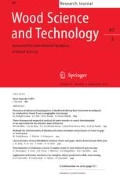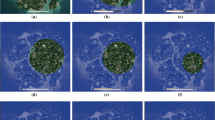Abstract
Cricket is a popular and increasingly wealthy bat-and-ball sport. Cricket bats made from willow are the focus of increasing scientific research and innovation, and in this paper, an innovative approach to improving the performance of cricket bats is described. Parametric modeling and genetic algorithms were used to converge the location of two points on a bat that are associated with increased velocity of a ball rebounding off bats: vibrational nodal points and center of percussion (COP). This modeling was able to reduce the distance between nodal points and COP from 174.5 to 98.1 mm. This change occurred as a result of modifications to the geometry of the bat notably shifting its mass toward its end, and keel-shaped sculpting of the back of the bat. These features are seen in some modern high-performance bats. However, the keel-shaped sculpting of the new bat was more sharply incurvate at the center and ends of the bat. The authors conclude that the combination of parametric modeling and optimization using genetic algorithms is a powerful tool for exploring virtual designs for cricket bats that are based on performance criteria, and suggest that additional novel bat designs could arise through multi-objective modeling and optimization using genetic algorithms.










Similar content being viewed by others
References
Allen T, Fauteux-Brault O, James D, Curtis D (2014) Finite element model of a cricket ball impacting a bat. Procedia Eng 72:521–526
Bahree M (2018) Wicket thicket. Forbes Asia 14(1):12–14
Bower R (2012) The sweet spot of a cricket bat for low speed impacts. Sport Eng 15(2):53–60
Brooks R, Mather JSB, Knowles S (2006) The influence of impact vibration modes and frequencies on cricket bat performance. Proc Inst Mech Eng Part L J Mater Des Appl 220(4):237–248
Cross R (1998) The sweet spot of a baseball bat. Am J Phys 66(9):772–779
Curtis D, Hurt G, Heller B (2014) The reliability of a tapping test as an indicator of cricket bat performance. Procedia Eng 72:666–671
Eftaxiopoulou T, Narayanan A, Dear JP, Bull AMJ (2012) A performance comparison between cricket bat designs. Proc Inst Mech Eng Part P J Sports Eng Technol 226(1):16–23
Fu ZF, He J (2001) Modal analysis. Butterworth-Heinemann, Oxford
Garner AWB, Newbery JL (1980) Cricket bat. US Patent 4,186,923. filed February 5
James D, Curtis D, Allen T, Rippin T (2012) The validity of a rigid body model of a cricket ball–bat impact. Procedia Eng 34:682–687
Jane FW (1970) Structure of wood. A & C Black, London
John S, Li ZB (2002) Multi-directional analysis of cricket bats. Eng Sport 4(1):96–103
Katiyar AK, Murtaza ST, Ali S (2018) Determining geometrical parameters for a referenced cricket bat handle. Eur J Phys Educ Sport Sci 4(3):158–164
Knowles S, Brooks F, Mather JSB (1996) Novel design of sports equipment through impact vibration analysis. In: Proceedings-SPIE the international society for optical engineering, pp 390–396
Marylebone Cricket Club (MCC) (2000) The laws of cricket. Marylebone Cricket Club, London
Mazloomi MS, Ranjbar M, Boldrin L, Scarpa F, Ozada N (2017) Structural-acoustic optimization of 2-D gradient auxetic sandwich panels. In: Medyna proceedings, pp 194–199
Mazloomi MS, Ranjbar M, Boldrin L, Scarpa F, Patsias S, Ozada N (2018) Vibroacoustics of 2D gradient auxetic hexagonal honeycomb sandwich panels. Compos Struct 187:593–603
McKay M, Beckman R, Conover W (1979) A comparison of three methods for selecting values of input variables in the analysis of output from a computer code. Technometrics 21:239–245
Noble L, Eck J (1986) Effects of selected softball bat loading strategies on impact reaction impulse. Med Sci Sport Exerc 18(1):50–59
Noble L, Walker H (1994) Baseball bat inertial and vibrational characteristics and discomfort following ball–bat impacts. J Appl Biomech 10(2):132–144
Petelet M, Iooss B, Asserin O, Loredo A (2010) Latin hypercube sampling with inequality constraints. AStA Adv Stat Anal 94(4):325–339
Russel DA (2017) Acoustics and vibration of baseball and soft ball bats. Acoust Today 13(4):35–42
Singh H (2008) Experimental and computer modelling to characterize the performance of cricket bats. Washington State University, United States
Smith LV, Singh H (2008) An examination of cricket bat performance. Eng Sport 7:474–482
Subic AJ, Cooke AJ (2003) Materials in cricket. Mater Sport Equip 1:342–375
Sutton AD (2008) Using modal analysis to investigate bat–ball performance of baseball bats. University of Massachusetts, Lowell, Lowell
Svanberg K (1987) The method of moving asymptotes—a new method for structural optimization. Int J Numer Methods Eng 24:359–373
Svanberg K (2002) A class of globally convergent optimization methods based on conservative convex separable approximations. SIAM J Optim 12(2):555–573
Swanson Analysis System Inc. (2014) ANSYS. Academia Research, Release 14
Symes AW (2006) The effect of mass distribution on cricket bat playing properties. Ph.D. Thesis, Loughborough University, United Kingdom
Turrin M, Von Buelow P, Stouffs R (2011) Design explorations of performance driven geometry in architectural design using parametric modeling and genetic algorithms. Adv Eng Informatics 25(4):656–675
Van Zandt LL (1992) The dynamical theory of the baseball bat. Am J Phys 60(2):172–181
Vedula G, Sherwood JA (2004) An experimental and finite element study of the relationship amongst the sweet spot, cop and vibration nodes in baseball bats. In: Proceedings of 5th conference on engineering of sport, vol 2, pp 626–632
Weyrich AS, Messier SP, Ruhmann BS, Berry MJ (1989) Effects of bat composition, grip firmness, and impact location on postimpact ball velocity. Med Sci Sports Exerc 21(2):199–205
Acknowledgements
PDE thanks Viance, Tolko, FPInnovations, Faculty of Forestry (UBC) and Government of British Columbia for their support of his BC Leadership Chair at UBC. PDE and MSM thank the Australian National University (ANU) for an Honorary Professorship and Research Fellowship, respectively, in the Department of Applied Mathematics, Research School of Physics at the ANU. MS thanks former Australian test cricketer, Brad Haddin, for giving us a Kookaburra Xenon cricket bat; Ben O’Reilly for providing us with willow clefts and Tim Senden for his continued support. This research used resources from the National Computational Infrastructure (NCI), which is supported by the Australian Government. None of the aforementioned organizations were involved in the collection, analysis or interpretation of data or the writing of this manuscript.
Author information
Authors and Affiliations
Corresponding author
Ethics declarations
Conflict of interest
On behalf of all authors, the corresponding author states that there is no conflict of interest.
Additional information
Publisher's Note
Springer Nature remains neutral with regard to jurisdictional claims in published maps and institutional affiliations.
Rights and permissions
About this article
Cite this article
Mazloomi, M.S., Saadatfar, M. & Evans, P.D. Designing cricket bats using parametric modeling and genetic algorithms. Wood Sci Technol 54, 755–768 (2020). https://doi.org/10.1007/s00226-020-01169-2
Received:
Published:
Issue Date:
DOI: https://doi.org/10.1007/s00226-020-01169-2




